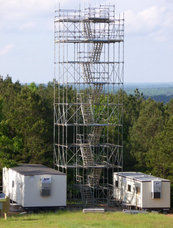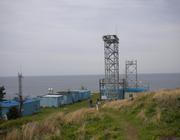
The Tropospheric Oxidation Capacity Research Group
Biosphere-Atmosphere-Human Interactions
3216 Croul Hall Irvine CA 92627 (email)

Observations of glyoxal and formaldehyde as metrics for the anthropogenic impact on rural photochemistry
Journal:
Atmospheric Chemistry and PhysicsVolume Number:
12Issue Number:
20Pages:
9529-9543Abstract:
We present simultaneous fast, in-situ measurements of formaldehyde and glyoxal from two rural campaigns, BEARPEX 2009 and BEACHON-ROCS, both located in Pinus Ponderosa forests with emissions dominated by biogenic volatile organic compounds (VOCs). Despite considerable variability in the formaldehyde and glyoxal concentrations, the ratio of glyoxal to formaldehyde, R-GF, displayed a very regular diurnal cycle over nearly 2 weeks of measurements. The only deviations in R-GF were toward higher values and were the result of a biomass burning event during BEARPEX 2009 and very fresh anthropogenic influence during BEACHON-ROCS. Other rapid changes in glyoxal and formaldehyde concentrations have hardly any affect on R-GF and could reflect transitions between low and high NO regimes. The trend of increased R-GF from both anthropogenic reactive VOC mixtures and biomass burning compared to biogenic reactive VOC mixtures is robust due to the short timescales over which the observed changes in R-GF occurred. Satellite retrievals, which suggest higher R-GF for biogenic areas, are in contrast to our observed trends. It remains important to address this discrepancy, especially in view of the importance of satellite retrievals and in situ measurements for model comparison. In addition, we propose that R-GF represents a useful metric for biogenic or anthropogenic reactive VOC mixtures and, in combination with absolute concentrations of glyoxal and formaldehyde, furthermore represents a useful metric for the extent of anthropogenic influence on overall reactive VOC processing via NOx. In particular, R-GF yields information about not simply the VOCs dominating reactivity in an airmass, but the VOC processing itself that is directly coupled to ozone and secondary organic aerosol production.
Notes:
ISI Document Delivery No.: 029BSTimes Cited: 0Cited Reference Count: 66DiGangi, J. P. Henry, S. B. Kammrath, A. Boyle, E. S. Kaser, L. Schnitzhofer, R. Graus, M. Turnipseed, A. Park, J-H. Weber, R. J. Hornbrook, R. S. Cantrell, C. A. Maudlin, R. L., III Kim, S. Nakashima, Y. Wolfe, G. M. Kajii, Y. Apel, E. C. Goldstein, A. H. Guenther, A. Karl, T. Hansel, A. Keutsch, F. N.COPERNICUS GESELLSCHAFT MBHGOTTINGEN
- Citation:
- DiGangi, JP, Henry SB, Kammrath A, Boyle ES, Kaser L, Schnitzhofer R, Graus M, Turnipseed A, Park JH, Weber RJ et al.. 2012. Observations of glyoxal and formaldehyde as metrics for the anthropogenic impact on rural photochemistry. Atmospheric Chemistry and Physics. 12(20):9529-9543.

